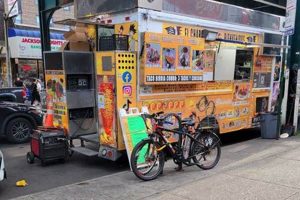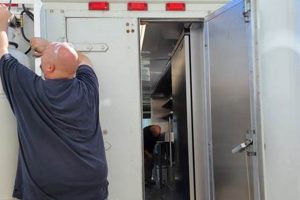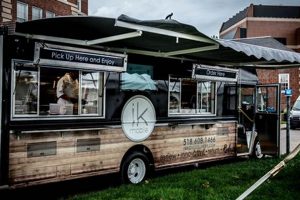Mobile culinary establishments, frequently observed at public events and urban centers, represent a segment of the food service industry characterized by its adaptability and direct consumer engagement. These businesses operate within compact, vehicle-based structures, offering a variety of menu items ranging from gourmet specialties to traditional comfort foods. A typical example is a self-contained kitchen within a truck, preparing and serving meals to customers directly from the vehicle.
These ventures offer several advantages, including reduced overhead costs compared to traditional brick-and-mortar restaurants, increased mobility allowing for access to diverse customer bases, and the potential for rapid expansion. Historically, these mobile eateries have evolved from simple vending carts to sophisticated culinary operations, reflecting changing consumer preferences and technological advancements in food preparation and service.
The following discussion will delve into key aspects of this mobile food service model, including operational considerations, regulatory compliance, menu development strategies, and marketing approaches tailored to a dynamic and competitive marketplace.
Operational Best Practices
Adherence to effective operational strategies is crucial for the sustainability and success of mobile culinary ventures. Diligence in these areas enhances efficiency, minimizes risks, and fosters customer satisfaction.
Tip 1: Menu Optimization: The menu should reflect culinary expertise while considering the limitations of a mobile environment. Prioritize dishes that are efficiently prepared, travel well, and appeal to the target demographic. Streamlining offerings minimizes inventory challenges and enhances order fulfillment speed.
Tip 2: Equipment Maintenance: Proactive maintenance is essential. Establish a rigorous schedule for the inspection, cleaning, and servicing of all cooking equipment, generators, and vehicle systems. Consistent upkeep minimizes downtime and ensures compliance with health and safety standards.
Tip 3: Inventory Management: Implement a system for meticulous tracking of all food supplies and consumables. Accurately forecasting demand minimizes waste and prevents stockouts. Consider a just-in-time inventory approach for perishable items to optimize freshness and reduce spoilage.
Tip 4: Location Strategy: Thoroughly research and select strategic operating locations. Consider factors such as pedestrian traffic, proximity to complementary businesses, and local event schedules. Secure any necessary permits and ensure compliance with local ordinances.
Tip 5: Staff Training: Invest in comprehensive training for all staff members. Emphasize food safety protocols, customer service excellence, and efficient order processing. Well-trained staff contributes to a positive customer experience and enhances operational effectiveness.
Tip 6: Technology Integration: Adopt technology solutions to streamline operations. Implement a point-of-sale (POS) system for efficient order management, payment processing, and sales tracking. Utilize mobile ordering platforms to expand reach and improve customer convenience.
Tip 7: Waste Management: Establish a responsible waste management system. Implement recycling programs and utilize biodegradable packaging materials to minimize environmental impact. Properly dispose of grease and other food waste in accordance with local regulations.
Consistent application of these best practices cultivates operational efficiency, safeguards product quality, and elevates customer satisfaction, which are all crucial elements for long-term viability.
These tips provide a foundation for the subsequent discussion on marketing strategies tailored for this unique business model.
1. Mobility
In the context of mobile food vending, mobility represents a defining characteristic that fundamentally shapes the operational model and market accessibility. It is the capacity to relocate and operate across diverse locations, offering a flexibility unattainable by traditional brick-and-mortar establishments. This inherent mobility dictates strategic decision-making across various facets of the business.
- Geographic Market Expansion
Mobility facilitates access to geographically dispersed customer segments. A mobile unit can strategically position itself at high-traffic locations during peak hours, capitalize on seasonal events, and target areas with limited dining options. For example, a mobile eatery might operate near construction sites during lunch hours or at outdoor concerts during the evening.
- Responsiveness to Demand Fluctuations
Mobility enables a quick response to shifting consumer demand. If a specific location experiences decreased foot traffic or increased competition, the unit can relocate to a more promising area. This agility reduces the risk of prolonged periods of low sales and optimizes revenue generation potential. A unit might move from a downtown office district on weekends to a residential area hosting community events.
- Minimization of Fixed Costs
Mobility mitigates the need for significant capital investment in permanent infrastructure. Unlike restaurants bound to a fixed address, mobile units avoid long-term leases, property taxes, and extensive building maintenance expenses. This translates to lower overhead costs and greater financial flexibility during the initial stages of operation and in response to economic downturns.
- Adaptation to Seasonal Variations
Mobility allows businesses to adapt to seasonal changes in customer behavior and environmental conditions. During warmer months, a unit might operate primarily outdoors at parks, beaches, or festivals. In colder months, it can relocate to indoor venues, such as office complexes or sporting arenas, or reposition itself to cater to the demand for warm beverages and comfort food.
The strategic utilization of mobility, therefore, constitutes a critical factor in maximizing revenue potential and ensuring the long-term viability of mobile food businesses. The examples highlighted underscore the inherent advantage of adaptability, enabling these operations to navigate diverse market conditions and consumer preferences effectively.
2. Menu Innovation
Menu innovation constitutes a critical differentiator and driver of success within the mobile food service sector. Given the inherent limitations of space and equipment within a mobile unit, coupled with the competitive landscape, a stagnant or unimaginative menu can significantly impede business growth. The creation of novel and appealing food offerings is essential for attracting and retaining customers, as well as establishing a unique brand identity.
The significance of menu innovation is multifaceted. First, it addresses evolving consumer preferences, including dietary trends, culinary interests, and demand for unique dining experiences. Mobile eateries that proactively introduce seasonal specials, internationally inspired dishes, or adaptations of classic comfort foods demonstrate responsiveness and culinary creativity. For instance, a truck specializing in gourmet grilled cheese sandwiches might offer monthly variations featuring artisanal cheeses, locally sourced ingredients, or innovative flavor combinations. Second, menu innovation can create a competitive advantage. By offering unique or hard-to-find items, a mobile vendor can attract customers seeking novel culinary experiences that are not readily available elsewhere. This can lead to increased customer traffic, higher average order values, and enhanced brand recognition. For example, a food truck offering exclusively vegan or gluten-free options caters to a niche market segment, differentiating itself from competitors. Finally, strategic menu adjustments can optimize operational efficiency within the confined space of a mobile unit. Simplifying preparation procedures, reducing the number of ingredients required, and streamlining the cooking process can improve order fulfillment speed and minimize waste. Examples include offering customizable bowls with a variety of base options, proteins, and toppings, or pre-packaging popular items for quick sale during peak hours.
In conclusion, continuous menu innovation is not merely an optional add-on but a foundational element for the survival and growth of mobile food businesses. By adapting to changing consumer tastes, creating a competitive edge, and optimizing operational efficiency, these enterprises can solidify their position in the market and establish a loyal customer base. Challenges include balancing creativity with practicality, accurately forecasting consumer demand, and maintaining consistent food quality. However, the potential rewards of a well-executed menu innovation strategy are substantial, underscoring its vital role in the mobile food service industry.
3. Operational Efficiency and Mobile Culinary Ventures
Operational efficiency is a critical determinant of profitability and sustainability for mobile culinary ventures. The compact and often confined spaces inherent in these businesses necessitate streamlined processes and resource optimization to maximize throughput and minimize waste. Inefficiencies in areas such as food preparation, order fulfillment, and inventory management directly impact the bottom line and overall competitiveness. For instance, a mobile unit utilizing a poorly designed workflow may experience delays in service, leading to customer dissatisfaction and lost sales. Conversely, a unit employing a standardized recipe system and a well-organized workspace can significantly reduce preparation time and increase the volume of orders processed per hour.
Furthermore, effective management of resources is paramount in mobile food operations. Limited storage capacity requires precise inventory control to prevent spoilage and stockouts. Implementing a just-in-time inventory system, where ingredients are purchased and replenished frequently based on demand, minimizes waste and ensures freshness. Similarly, optimizing energy consumption through the use of energy-efficient equipment and strategic scheduling of cooking activities can reduce operating costs. The practical significance of understanding and prioritizing operational efficiency is evident in the ability of a mobile eatery to consistently deliver high-quality food in a timely manner, while maintaining competitive pricing and maximizing profit margins. For example, a mobile coffee vendor employing an automated espresso machine and a streamlined ordering process can serve a higher volume of customers during peak hours compared to a vendor relying on manual operations.
In summary, operational efficiency is not merely a desirable attribute, but a fundamental requirement for the success of mobile culinary businesses. By focusing on process optimization, resource management, and technology integration, these ventures can overcome the inherent challenges of operating in a confined space and achieve a competitive advantage. Continual evaluation and refinement of operational practices are essential for adapting to changing market conditions and ensuring long-term viability in the dynamic mobile food service landscape.
4. Regulatory Compliance
Adherence to regulatory mandates represents a non-negotiable aspect of operating a mobile food vending unit. Non-compliance carries significant consequences, ranging from operational shutdowns and fines to legal liabilities and reputational damage. The intricate web of regulations governing these businesses originates from various levels of government, encompassing federal, state, and local authorities, each with specific areas of oversight.
The areas of regulatory focus typically include food safety standards, health codes, permitting requirements, zoning restrictions, and fire safety regulations. For example, a mobile food unit must adhere to strict guidelines regarding food handling, storage temperatures, and sanitation practices to prevent foodborne illnesses. Compliance often necessitates routine inspections, proper employee training, and meticulous record-keeping. Additionally, securing the necessary permits and licenses from local authorities is essential for legal operation. Zoning ordinances dictate where a mobile unit can operate, often restricting operation near schools, residential areas, or established restaurants. Fire safety regulations mandate the use of fire suppression systems and adherence to specific guidelines regarding propane storage and ventilation.
The practical significance of regulatory compliance extends beyond mere legal adherence. It fosters consumer trust, protects public health, and contributes to a level playing field within the industry. A mobile food unit with a demonstrated commitment to regulatory compliance signals to customers that it prioritizes safety and quality. This, in turn, can enhance brand reputation and foster customer loyalty. While navigating the complexities of regulatory compliance can be challenging, particularly for new entrants to the market, proactive engagement with regulatory agencies and investment in compliance resources are essential for long-term success. Failure to prioritize regulatory compliance can have devastating consequences, undermining the viability of the entire enterprise.
5. Customer Engagement
Customer engagement represents a critical determinant of success for mobile food vendors. Unlike traditional brick-and-mortar restaurants, these mobile businesses rely heavily on building direct relationships with their customer base to foster loyalty and sustain revenue streams. Proactive and effective engagement strategies are paramount for attracting new customers, retaining existing ones, and establishing a positive brand reputation within the community.
- Social Media Integration
Social media platforms serve as indispensable tools for mobile food businesses. Consistent posting of location updates, menu specials, and promotional offers keeps customers informed and incentivized to visit. Real-time interaction with followers, responding to inquiries and addressing concerns, cultivates a sense of community and demonstrates attentiveness to customer needs. For example, a food truck might announce its daily location on Twitter, Instagram, and Facebook, or host contests inviting customers to submit photos or videos featuring their food for a chance to win prizes.
- Loyalty Programs
Implementing a loyalty program can effectively incentivize repeat business. Offering rewards for frequent purchases, such as a free item after a certain number of visits, encourages customers to return and strengthens brand loyalty. Loyalty programs can be implemented through physical punch cards, mobile apps, or digital tracking systems. A coffee truck might offer a free drink after ten purchases, while a sandwich truck might provide a discount on a customer’s birthday.
- Community Involvement
Active participation in local community events fosters goodwill and enhances brand visibility. Sponsoring local sports teams, donating food to charitable organizations, or participating in community festivals demonstrates a commitment to the community and generates positive public relations. A mobile eatery might donate a portion of its proceeds to a local school or offer catering services for community events.
- Personalized Interactions
Providing personalized service can significantly enhance the customer experience. Remembering regular customers’ names and preferences, offering customized menu options, and engaging in friendly conversation creates a welcoming atmosphere and fosters a sense of connection. A food truck employee might greet a regular customer by name and offer a sample of a new dish.
These facets of customer engagement, when implemented strategically, can significantly contribute to the success of mobile food vending operations. By prioritizing direct interaction, building relationships, and demonstrating a commitment to customer satisfaction, these businesses can cultivate a loyal following and establish a strong presence in the competitive food service market. Further refinement of these strategies might involve the integration of data analytics to better understand customer preferences and tailor engagement efforts accordingly.
6. Financial Sustainability
Financial sustainability represents a core prerequisite for the long-term viability of any mobile food vending operation. It signifies the ability to generate sufficient revenue to cover operating expenses, service debt obligations, and reinvest in the business for future growth. The absence of financial sustainability inevitably leads to operational curtailment or outright business failure, regardless of culinary expertise or customer appeal. A mobile unit consistently operating at a loss, despite positive customer feedback, cannot maintain its operations indefinitely. The interplay of factors impacting financial sustainability necessitates diligent management across all aspects of the business.
Several elements contribute directly to the financial health of a mobile food business. Effective cost control, encompassing ingredient sourcing, fuel consumption, and labor management, is paramount. Strategic menu pricing, balancing customer affordability with profitability, is essential. Maximizing revenue generation through efficient service, strategic location selection, and targeted marketing campaigns directly impacts the bottom line. Furthermore, prudent financial planning, including budgeting, cash flow management, and capital expenditure forecasting, ensures the business can weather unforeseen economic fluctuations or operational challenges. For example, a food truck specializing in gourmet tacos might implement a dynamic pricing strategy, adjusting prices based on ingredient costs and demand fluctuations to maximize profitability.
In summary, financial sustainability is not a static state but a dynamic process requiring continuous monitoring, analysis, and adaptation. By prioritizing cost control, revenue generation, and prudent financial management, mobile food vendors can enhance their financial resilience and secure long-term success in a competitive market. Neglecting these principles, even with a popular menu and a prime location, ultimately jeopardizes the survival of the enterprise. The interconnection of sound financial practices with operational strategies is critical for ensuring the continued function and expansion of a successful mobile culinary establishment.
Frequently Asked Questions
The following addresses common inquiries regarding the operation and regulation of mobile food vending units, providing concise and informative answers.
Question 1: What permits and licenses are typically required to operate a mobile food vending unit?
The permits and licenses necessary vary depending on the jurisdiction but generally include a business license, a food handler’s permit for all employees, a mobile food vending permit, and potentially specialized permits related to propane usage or specific food items.
Question 2: How frequently are mobile food vending units subject to health inspections?
The frequency of health inspections is determined by local health departments, based on factors such as the type of food served, the unit’s inspection history, and any reported complaints. Inspections can range from monthly to annually.
Question 3: What are the standard food safety requirements for mobile food vending operations?
Standard food safety requirements encompass proper food storage temperatures, adequate handwashing facilities, prevention of cross-contamination, and adherence to safe food handling practices. Detailed guidelines are typically available from local health departments.
Question 4: Are there restrictions on where a mobile food vending unit can operate?
Zoning regulations and permitting stipulations often dictate the permissible operating locations. Restrictions may include proximity to schools, residential areas, or established restaurants, as well as limitations on operating hours.
Question 5: What are the common challenges faced by mobile food vending businesses?
Common challenges include weather dependency, limited space and storage, regulatory compliance, competition from other vendors, and the need for constant relocation and setup.
Question 6: How can a mobile food vending unit effectively market its services?
Effective marketing strategies encompass social media engagement, targeted advertising, participation in community events, loyalty programs, and building relationships with local businesses.
Understanding and addressing these fundamental questions provides a solid foundation for navigating the mobile food vending industry and ensuring regulatory compliance.
The subsequent discussion will delve into strategies for optimizing menu development and operational efficiency in this sector.
In Summary
This exploration of the diner on the go food truck concept has illuminated the multifaceted aspects of this dynamic sector. From operational efficiency and regulatory compliance to menu innovation and customer engagement, each element contributes to the overall viability and success of these mobile culinary ventures. Adherence to best practices in these areas is not merely advantageous, but essential for navigating a competitive marketplace and ensuring long-term sustainability.
As consumer preferences continue to evolve and regulatory landscapes shift, adaptability and a commitment to innovation will remain paramount. Prospective and current operators within the diner on the go food truck domain must prioritize continuous improvement, strategic planning, and a customer-centric approach to thrive in this ever-changing environment. Further research and diligence are encouraged to ensure continued success in this vibrant segment of the food service industry.





![Guide to Midland Food Truck Scene Near You - [Year] World’s Most Delicious Foods: Must-Try Dishes from Every Country Guide to Midland Food Truck Scene Near You - [Year] | World’s Most Delicious Foods: Must-Try Dishes from Every Country](https://lisasfoods.com/wp-content/uploads/2025/12/th-433-300x200.jpg)

